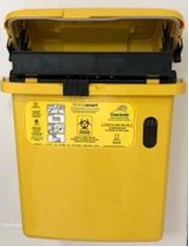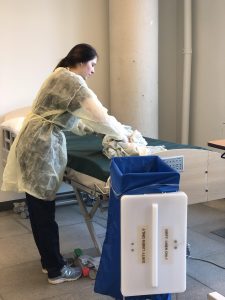Maintaining a Healthy Workplace Environment
Environmental services, including housekeeping, are educated and trained to prevent transmission of infections within healthcare settings. Listen to Karen Barnes as she describes the role of environmental services in infection prevention and control practices, and their responsibility for maintaining a healthy workplace environment.
Digital Story with Karen Barnes
Cleaning and Handling Medical Equipment
Reusable medical equipment that touches intact skin and does not touch mucous membranes must be cleaned between clients. Examples of this equipment include stethoscopes, BP cuffs, pulse oximeters, and wheelchairs. Most of this equipment does not become visibly soiled, so disinfecting the equipment with a wipe is usually sufficient (PIDAC, 2018). Depending on the equipment size, this can be achieved with an alcohol pad (e.g., on a stethoscope) or a larger disinfectant wipe (PIDAC, 2018).
When cleaning, disinfecting, or sterilizing equipment, as well as the environment, follow infection prevention and control best practices and agency policy regarding type of solution, frequency of cleaning required, and duration that the solution should remain on specific equipment or surface area before wiping off or reusing.
The following video demonstrates how to disinfect a wheelchair after each use to prevent the spread of infection between clients and healthcare providers. Key points to remember are to disinfect from cleanest to dirtiest areas and to give extra care to high-touch areas. High-touch areas need to be disinfected more frequently.
Watch this following video to learn how to properly disinfect wheelchairs:
Dispose of sharps, including needles, in designated puncture-proof containers. When containers are ¾ full, call environmental services or dispose of containers according to agency policy. Do not clean or dust the top of a sharps contain to avoid risk of a needle stick or sharp injury (PIDAC, 2018). Only clean the sides and bottom of the sharps container. It is everyone’s responsibility to ensure safe disposal of sharps and replacement of needle containers.
Clinical Tip
If you work with or will be exposed to needles or sharps (e.g., scalpels, lancets, ends of IV tubing, sutures, blades, glass) you are at risk of a needle/sharp injury. Working with or being exposed to sharps can cut or puncture your skin increasing your risk of exposure to microorganisms. To decrease your risk of injury, always perform a risk assessment to assess the environment and client’s required care. It is important to be alert for and aware of potential exposure to needles and other sharp objects in the client’s environment.
When using needles or sharps, follow safety protocols as outlined by the facility. For example:
- Plan care and safe handling of the needle before providing client care.
- Use a needleless system when available.
- Use needle safety devices.
- Never recap needles.
- Immediately dispose of needles or sharps after use.
- Report any needle or sharp injuries according to the facility’s occupational health policies.
If you are not directly handling sharps, though will be in an environment in which you may be exposed to sharps, follow the same safety measures. Sharps have been accidentally left in linen, laundry, on bedside tables, on the floor, and in waste bins in client’s rooms. Incorrectly disposal of needles and sharps can cause injuries and infection from blood and body fluid transmission. If you see a needle or sharp, carefully dispose of it by:
- Putting on a pair of gloves.
- If possible, bringing the sharps container to the needle or sharp.
- Never recapping a needle device.
- Using a mechanical device (e.g., tongs) to place it into the sharps container.
- Reporting the incident to your manager and according to the facility’s occupational health policies.
Prevention strategies for needle and sharp injuries include:
- Wearing gloves when handling sharps.
- Closing and replacing sharps containers once ¾ full.
- Being aware of potential needles and sharps in linen or waste bin.
- Wearing protective footwear to protect your feet from punctures.

Review and educate yourself on the healthcare setting policies and procedures on:
- Sharp safety and injury prevention programs.
- Post-exposure and prophylaxis follow up care requirements.
(PIDAC, 2018)
Cleaning and Handling Linens
Routine practices should be followed when handling linen. Linens include clients’ gowns, towels, and sheets. If the client is on additional precautions, special handling of linen should be followed according to the healthcare setting infection prevention and control policies. Linens should be disposed of in the appropriate linen hamper. If the linen hamper is overflowing, it is important that you change it wearing the appropriate PPE or notify your institution’s healthcare environmental services department. Linen bags should not be overfilled and should be tied securely when transporting (PIDAC, 2018). Soiled linen, when not properly handled, can expose healthcare providers to and increase their risk of transmission of infectious microorganisms. Full soiled linen bags should never be stored on the floor.
 Avoid touching your uniform with the soiled linen because this can indirectly transmit infectious microorganisms to yourself, another surface, or another person. If there is a risk that soiled linens will come into contact with your uniform or exposed skin, you need to wear the appropriate PPE (e.g., gloves, gown) as needed. If you need to change the bed linen, or sheets on a treatment table, avoid shaking the linens because shaking can expel microorganisms into the air and increase the risk of transmission. Follow the healthcare institutions linen policies regarding gathering, handling and transporting linen.
Avoid touching your uniform with the soiled linen because this can indirectly transmit infectious microorganisms to yourself, another surface, or another person. If there is a risk that soiled linens will come into contact with your uniform or exposed skin, you need to wear the appropriate PPE (e.g., gloves, gown) as needed. If you need to change the bed linen, or sheets on a treatment table, avoid shaking the linens because shaking can expel microorganisms into the air and increase the risk of transmission. Follow the healthcare institutions linen policies regarding gathering, handling and transporting linen.
Changing into your uniform once at your placement site keeps the uniform clean and decreases the risk of contamination en route to your facility. While working, keep your uniform clean and avoid contamination by wearing a gown as needed. After work, change out of your uniform prior to leaving the facility. You should wear a clean uniform for each new day at placement. Some clinical placements will provide you with a clean uniform each shift. For example, when working in the operating room or emergency department.
To learn about the specific guidelines related to occupational health and safety issues related to environmental services, please review Public Health Ontario’s Best Practices for Environmental Cleaning for Prevention and Control of Infections in All Health Care Settings, 3rd Edition (2018) located at https://www.publichealthontario.ca/-/media/documents/B/2018/bp-environmental-cleaning.pdf
Clinical Tip
Healthcare providers may mobile devices (e.g., pager, smart phone, personal digital assistant) during client care. For example, when checking on lab values, or receiving alerts regarding the client or scanning labels. Phones are considered a high-touch surfaces and need frequent cleaning. If your phone is part of your care then you must follow the healthcare setting policies regarding when and how to clean the phone, such as between each client or procedures. If your healthcare setting does not have a policy, follow Public Health Ontario guidelines. Your phone would be treated as all other medical equipment (e.g., blood pressure cuff, stethoscope) and needs to be cleaned frequently to decrease the risk to transmitting microorganisms between clients, yourself, and the healthcare team. It is also important to follow the phone manufacture guidelines regarding cleaning to ensure you do not damage it or cause other malfunctions (e.g., fire, burns). If you are unable to clean your phone, then it should not be used in the healthcare setting. Instead, use a phone provided by the facility that can be cleaned to prevent the spread of microorganisms. In addition, you can educate client’s on when and how to clean their phones too.
For more information on cleaning and disinfecting electronic devices review Alberta Health Services (2020) guidelines.
Test your Knowledge
The following image is from the case scenario of the OTA & PTA exercise and activity class for residents, click on the various hotspots to learn which items are high-touch areas and would require more attention to be cleaned and disinfected.
Attribution
This page was remixed with our own original content and adapted from:
Clinical Procedures for Safer Patient Care — Thompson Rivers University Edition by Renée Anderson, Glynda Rees Doyle, and Jodie Anita McCutcheon is used under a CC BY 4.0 Licence. This book is an adaptation of Clinical Procedures of Safer Patient Care by Glynda Rees Doyle and Jodie Anita McCutcheon, which is under a CC BY 4.0 Licence. A full list of changes and additions made by Renée Anderson can be found in the About the Book section.
Physical Examination Techniques: A Nurse’s Guide by Jennifer Lapum, Michelle Hughes, Oona St-Amant, Wendy Garcia, Margaret Verkuyl, Paul Petrie, Frances Dimaranan, Mahidhar Pemasani, and Nada Savicevic is licensed under a Creative Commons Attribution-NonCommercial 4.0 International License, except where otherwise noted.

